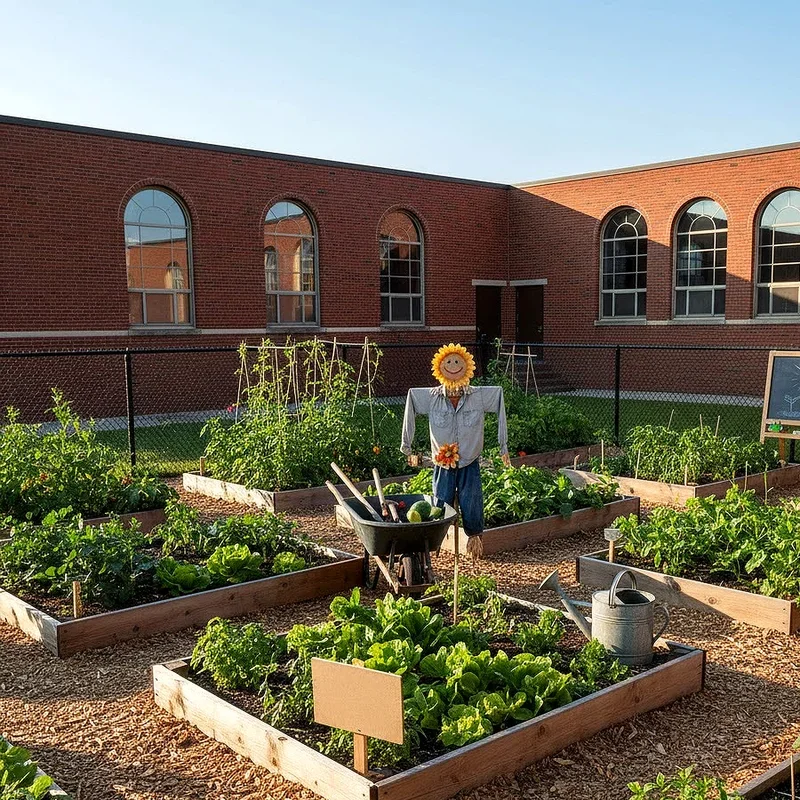15 School Garden Ideas to Inspire Young Learners
Transform learning with 15 creative school garden ideas that spark curiosity, teach responsibility, and connect students with nature in meaningful ways.
Have you ever watched a child's face light up when they see their first seedling sprout from the soil? School gardens create magical learning laboratories where textbooks come alive and abstract concepts take root in real experiences. These outdoor classrooms transform education by engaging multiple senses while teaching everything from science and math to patience and responsibility. Students who participate in gardening programs show improved academic performance, better nutritional choices, and stronger connections to their environment. Whether your school has acres of land or just a small courtyard, creating a garden space opens doors to endless educational opportunities. Let's explore fifteen innovative garden ideas that will inspire young learners to dig deeper into their education while cultivating essential life skills that extend far beyond the classroom walls.
1. Butterfly and Pollinator Gardens
Creating a butterfly garden teaches students about life cycles, ecosystems, and the crucial role pollinators play in our food system. Plant milkweed for monarchs, zinnias for bees, and sunflowers for birds to create a bustling habitat right on school grounds. Students can observe metamorphosis firsthand by raising caterpillars in the classroom before releasing butterflies into their garden. This living laboratory helps children understand interdependence in nature while developing observation and documentation skills through journals and photography. The garden becomes a research station where students track visitor patterns, identify species, and learn about migration routes. Adding water features, logs, and rocks creates microhabitats that attract diverse wildlife throughout the seasons.
2. Pizza Garden with Herbs and Vegetables
Who says learning can't be delicious? Design a circular garden divided into pizza slice sections, each growing ingredients like tomatoes, peppers, basil, oregano, and onions. This themed approach makes gardening relatable and exciting while teaching nutrition, cultural studies, and basic cooking skills. Students calculate the area of their pizza slices during math class, study plant biology in science, and write recipes in language arts. The harvest celebration becomes a community event where students prepare and share pizzas made from their homegrown ingredients. This garden demonstrates farm-to-table concepts while encouraging healthier eating habits and appreciation for fresh produce. Watch as even the pickiest eaters become curious about vegetables they've grown themselves.
3. Rainbow Garden with Colorful Plants
Transform your schoolyard into a living rainbow by organizing plants according to their colors in spectrum order. Red tomatoes transition to orange marigolds, yellow sunflowers, green lettuce, blue cornflowers, and purple eggplants create a visual feast. This arrangement teaches color theory, artistic design principles, and plant identification while creating an Instagram-worthy space that students take pride in maintaining. Art classes can paint the garden, science classes study light wavelengths and photosynthesis, and younger students learn their colors through hands-on experiences. The rainbow theme makes it easy for children to remember plant locations and creates natural sections for different grade levels to maintain. This visually striking garden becomes a landmark that builds school identity and community pride.
4. Sensory Garden for Multi-Sensory Learning
Design a garden that engages all five senses through carefully selected plants and features. Include lamb's ear for touch, lavender for smell, cherry tomatoes for taste, rustling grasses for sound, and bright flowers for sight. This inclusive space supports diverse learning styles and provides therapeutic benefits for students with special needs or sensory processing differences. Teachers can conduct mindfulness exercises, descriptive writing workshops, and scientific observations in this calming environment. Add wind chimes, water features, and textured pathways to enhance the sensory experience throughout the seasons. The garden becomes a retreat where stressed students find peace and overwhelmed learners can reset their nervous systems. Every child discovers their own way to connect with nature through their strongest sensory pathway.
5. Native Plant Garden for Local Ecology
Establish a native plant garden that showcases your region's natural heritage while requiring minimal maintenance once established. Students research indigenous species, learn about historical land use, and understand how native plants support local wildlife better than exotic alternatives. This garden connects children to their bioregion while teaching environmental stewardship and conservation principles. Partner with local indigenous communities or naturalist groups to share traditional plant knowledge and cultural connections. Students can create field guides, conduct biodiversity surveys, and monitor seasonal changes specific to their area. The garden demonstrates sustainable landscaping practices that students can replicate at home. This living classroom teaches that working with nature, rather than against it, creates resilient and beautiful spaces.
6. Vertical Gardens for Small Spaces
When ground space is limited, grow up instead of out with creative vertical gardening solutions. Install trellises for climbing beans, use recycled pallets for herb walls, or create hanging gardens with repurposed bottles and containers. These space-saving techniques teach engineering concepts, problem-solving skills, and resource efficiency while maximizing growing area in urban schools. Students design and build structures, calculate weight loads, and experiment with different growing mediums and irrigation systems. Vertical gardens create green walls that improve air quality, reduce noise, and provide cooling shade for outdoor learning spaces. This approach shows students that anyone can garden regardless of space limitations. The vertical dimension adds visual interest while teaching that creativity can overcome any obstacle.
7. Composting Station and Worm Farms
Transform cafeteria waste into garden gold by establishing composting systems that complete the nutrient cycle. Students learn decomposition science, waste reduction strategies, and circular economy principles while producing rich soil amendments for their gardens. Worm bins provide fascinating observations of these ecosystem engineers at work, turning scraps into valuable vermicompost. Track temperature changes, measure pH levels, and document decomposition rates to integrate real data into science and math lessons. This hands-on waste management system reduces the school's environmental footprint while teaching responsibility and systems thinking. Students become waste warriors who understand their role in solving environmental challenges. The finished compost closes the loop, showing how waste becomes resource when we work with natural processes.
8. Weather Station Garden
Combine meteorology with horticulture by installing weather monitoring equipment alongside climate-responsive plantings. Students track rainfall, temperature, wind speed, and sunlight hours while observing how weather patterns affect plant growth and garden productivity. This data-rich environment supports STEM learning through authentic research and long-term observation projects. Create microclimates using walls, water features, and windbreaks to demonstrate how environmental factors influence growing conditions. Students can compare their data with regional weather services and participate in citizen science projects. The garden becomes a laboratory for studying climate change impacts and adaptation strategies. This integration of technology and nature prepares students for careers in agricultural science, meteorology, and environmental monitoring.
9. Literature Garden Based on Favorite Books
Bring stories to life by planting gardens inspired by beloved children's books like Peter Rabbit's vegetable patch or the Secret Garden's hidden sanctuary. Students connect reading with real-world experiences while developing deeper comprehension and emotional connections to literature. Create reading nooks among the plants where classes can enjoy stories surrounded by their literary landscapes. Each grade level can adopt a different book theme, allowing progression through increasingly complex narratives and garden designs. Students write their own garden stories, illustrate plant journals, and perform dramatic readings in their outdoor theater. This interdisciplinary approach strengthens literacy skills while fostering imagination and creative expression. The garden becomes a living library where stories bloom alongside the flowers.
10. Cultural Heritage Garden
Celebrate diversity by growing plants that represent different cultures within your school community. Families share seeds, stories, and growing techniques from their heritage, creating a multicultural tapestry of flavors, colors, and traditions. Students learn geography through crop origins, explore cultural celebrations involving specific plants, and develop global awareness through garden-based connections. Host international harvest festivals where families prepare traditional dishes using garden produce. This inclusive space builds bridges between home and school while validating every student's cultural identity. Recipe exchanges, storytelling sessions, and traditional planting ceremonies create rich learning experiences. The garden becomes a meeting ground where differences are celebrated and common ground is cultivated through shared growing experiences.
11. Medicinal and Healing Garden
Explore the intersection of plants and human health by cultivating herbs and flowers with therapeutic properties. Students learn about traditional medicine, pharmaceutical development, and the historical relationship between gardens and healing while growing calendula, echinacea, chamomile, and mint. This garden opens discussions about wellness, self-care, and the importance of understanding what we put in our bodies. Partner with local herbalists or cultural practitioners to share knowledge about plant medicine traditions. Students can make simple preparations like herbal teas, salves, and sachets while learning about safety and proper identification. The garden demonstrates that many modern medicines originated from plants. This knowledge empowers students to appreciate both traditional wisdom and scientific advancement in healthcare.
12. Alphabet Garden with A-Z Plants
Design an alphabetical adventure where each letter corresponds to a different plant, from Asters to Zinnias. This organizational system helps younger students learn letters while older students research botanical names, plant families, and scientific classification systems. Create signage that includes both common and scientific names, supporting vocabulary development across grade levels. Students can write alphabet books, create plant dictionaries, and play word games using their garden vocabulary. This systematic approach teaches organization, categorization, and attention to detail while making the garden accessible to beginning readers. The alphabet framework provides structure while allowing flexibility to swap plants seasonally. Every visit becomes a literacy lesson where students spell out words with living letters.
13. Science Experiment Garden
Dedicate plots to controlled experiments where students test variables like fertilizer types, watering schedules, companion planting, and light exposure. This living laboratory teaches scientific method through hypothesis formation, data collection, analysis, and conclusion drawing. Students develop critical thinking skills while discovering what makes plants thrive or struggle. Design experiments that align with grade-level science standards, from simple observations for kindergarteners to complex investigations for middle schoolers. Document findings in lab notebooks, create data visualizations, and present results at science fairs. The garden provides endless opportunities for authentic inquiry-based learning. Failed experiments become valuable lessons about resilience, problem-solving, and the iterative nature of scientific discovery.
14. Seasonal Rotation Garden
Teach planning and patience through a four-season garden that changes with nature's rhythm. Students learn about crop rotation, succession planting, and seasonal eating while maintaining year-round engagement with their outdoor classroom. Spring peas give way to summer tomatoes, followed by fall pumpkins and winter greens, demonstrating agricultural cycles and sustainability. Create seasonal celebration gardens with spring bulbs, summer annuals, autumn harvest crops, and winter interest plants. This approach teaches patience, planning, and adaptation while providing fresh learning opportunities throughout the school year. Students develop long-term thinking skills and understand that good things take time. The changing garden reflects life's cycles and teaches that every season has its purpose and beauty.
15. Aquaponics and Hydroponic Systems
Introduce cutting-edge agricultural technology through soil-free growing systems that combine fish farming with vegetable production. Students explore sustainable food systems, water conservation, and innovative solutions to global food security challenges while maintaining these fascinating closed-loop ecosystems. This high-tech approach appeals to students interested in engineering, technology, and modern farming methods. Monitor water quality, adjust nutrient solutions, and optimize growing conditions using real-time data and digital tools. These systems produce impressive yields in minimal space while using significantly less water than traditional gardens. Students learn about career opportunities in agricultural technology and sustainable food production. The combination of living systems and technology prepares students for the future of farming.
Conclusion
School gardens cultivate more than just plants; they grow confident, curious, and connected young learners who understand their relationship with the natural world. These fifteen ideas offer starting points for creating outdoor classrooms that support diverse learning styles, curriculum goals, and student interests. Whether you implement one idea or combine several, remember that the most important harvest is the knowledge, skills, and memories students gain through hands-on growing experiences.
Read next: 15 Creative Garden Ideas to Transform Your Space
Frequently Asked Questions
Q1: How much space do we need to start a school garden?
A: Even small container gardens or window boxes can create meaningful learning experiences.
Q2: What's the best season to start a school garden project?
A: Spring offers ideal growing conditions, but planning can begin any time.
Q3: How can we fund our school garden initiative?
A: Apply for grants, organize fundraisers, and seek donations from local businesses.
Q4: Who should be responsible for summer garden maintenance?
A: Create volunteer schedules involving families, staff, and community members for coverage.
Q5: What if we don't have gardening experience or knowledge?
A: Partner with master gardeners, extension services, or community volunteers for expertise.













































